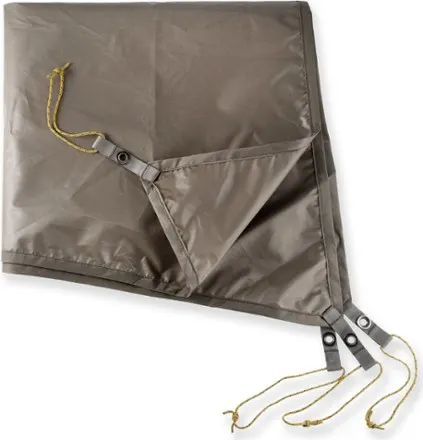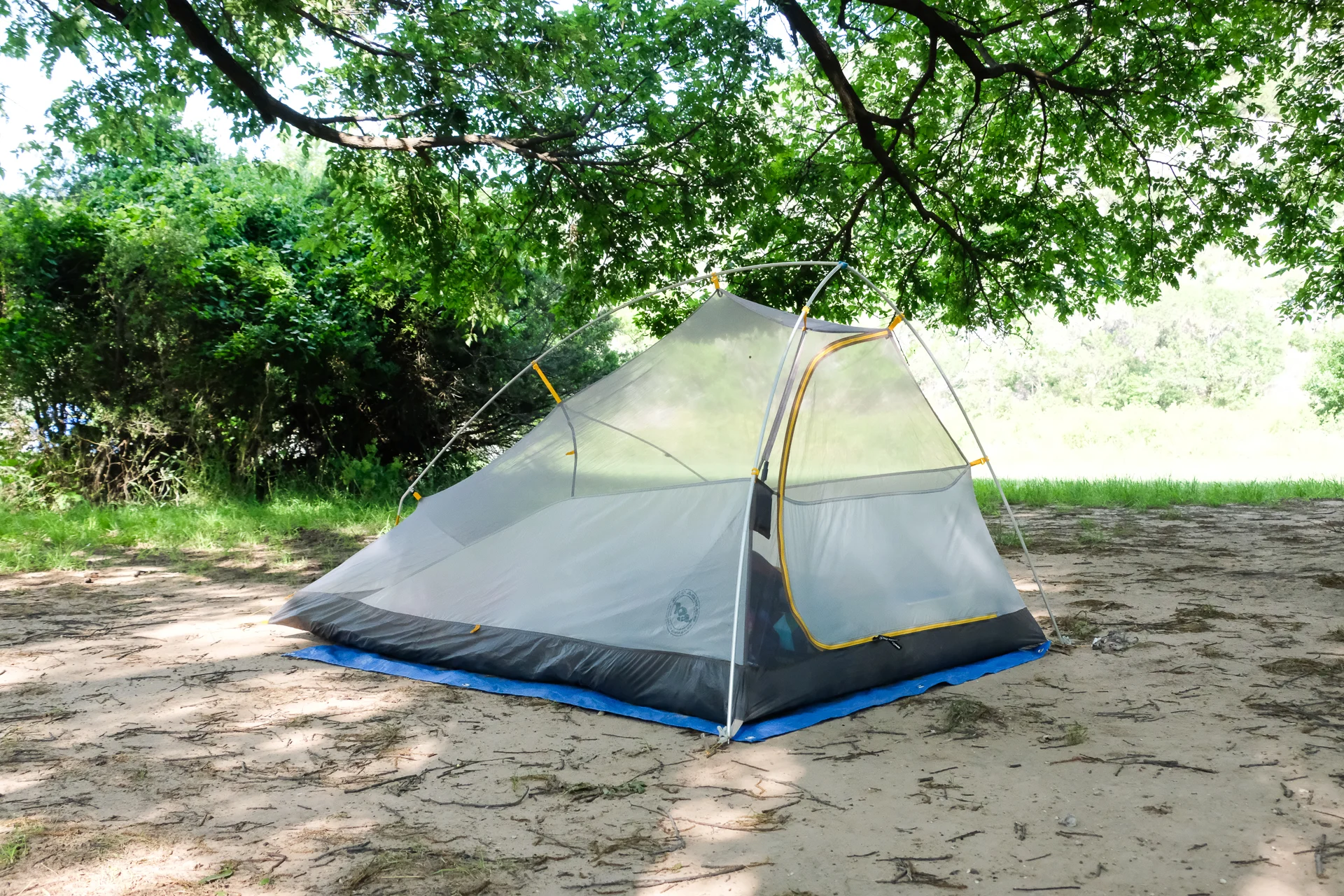The Best Deals on Camping, Backpacking and Outdoor Gear [June 2025]
A Tent footprint: maybe you’ve heard of it. Maybe you’re all what even is that? Maybe you wouldn’t be caught dead pitching your tent without one. Maybe you’ve decided to finally figure out once and for all if a footprint is even worth it. Well, whatever your position on tent footprints (or ground cloths or tarps or whatever you prefer to call them), their use is a source of hot debate in the outdoor community. So let’s settle the great footprint debate once and for all, shall we?

What is a Tent Footprint for?
There are plenty of questions that pop up when you mention ground cloths in a group of outdoor enthusiasts: Should you use one? Is it worth the money? Does it go inside your tent or out? How big should it be? What makes a good footprint? So many questions! Well, we have answers!
For starters, a ground cloth, tarp, and footprint are all the same thing when you’re talking tents. What do they do? Well, that depends on who you ask. Some will say they’re meant to keep water out or help keep the inside of your tent clean, and sure, they can be used for those purposes, but a groundcloth or tent footprint’s main purpose is to protect the floor of your tent.
Yes, its function is that basic. Because when you pitch a nice, clean, expensive tent directly on the ground, chances are, you’re not pitching it on top of a perfectly fluffy patch of grass or soft sand or some similarly cushy substance. There are probably rocks and sticks and pebbles and burs and thorns and all manner of pokey items on the ground underneath your tent.
And when your tent goes on top of that stuff and then you go in your tent and lay down and roll around and climb in and out, you’re basically grinding all that stuff into the fabric of your tent floor, which over time, can cause damage, especially if you’re using an ultralight model made of delicate, often easily puncturable, material.
So a tarp placed underneath your tent, between the ground and the tent floor, helps prolong the life of that nice tent you scrimped and saved for.
But yes, it also helps keep the inside of your tent dry in wet or rainy weather. See, water and moisture from the ground can seep into lighter weight tents, even if they claim to be waterproof, especially if it’s super rainy or there’s snow on the ground and you have an older tent or one that could use a good re-waterproofing (read more about how to maintain your waterproof gear here). Place a ground cloth underneath your backcountry castle, though, and you have an extra layer or protection between your tent floor and the soggy earth beneath it.

Do I Need a Tent Footprint?
However, footprints can be rather expensive (for something whose sole purpose is to be spread on the ground to get filthy) and you usually have to find one from the same manufacturer as your tent to ensure it’s exactly the right size and shape (more on that later)…So if you’re on a budget or are ultralight backpacking and you’re wondering if a ground cloth is worth the weight, the answer is: maybe.
If you didn’t pay that much for your tent and it’s already got a nice sturdy floor, then no, a footprint is probably a waste of money for most fair-weather camping excursions. But if you went out and bought yourself a $300 or $400 ultralight model for backpacking, well, that’s a different story.
Because ultralight tents tend to be made of lighter and less rugged materials. Which means your tent floor is probably going to start showing signs of wear a lot sooner. And what would you rather do: buy a replaceable groundcloth every few years for $35 or a brand new tent because the earth ate through your floor?
As for the issue of inclement weather, the same general guidelines apply: if you have a super heavy duty tent with a rugged, waterproof bathtub floor, then you probably don’t need the extra protection of a tarp, but it certainly never hurts.
How do I Use a Tent Footprint?
So you have a ground cloth. What do you do with it? Some folks think you should put your footprint inside your tent because rain can sometimes sneak in between your tarp and tent floor and then seep up into the inside of the tent. A tarp on the inside would block this moisture from soaking into your sleeping bag. But, with a waterproof tent, this shouldn’t happen. In our Big Agnes Tiger Wall, for example, which is an ultralight tent, we’ve camped in the rain many times, and even when we look down and see that water has made its way in between our tarp and the outside of our tent floor, the inside of the tent is almost never even damp.
But if it was, it would probably be because we were using the wrong size footprint. See, if your footprint is even an inch larger than the floor of your tent, chances are it’s sticking out enough to catch rainwater dripping off your rain fly, which means you’re going to start seeing puddles form between the tent floor and the footprint, and in some tents, that can mean leakage into the inside of your shelter. Which is obviously no bueno.
However, if you purchase a footprint that’s designed specifically for your tent, that shouldn’t happen; it should be exactly the right size. But if you’re making do with something else–and no shame there; we’ve spent years using a generic blue tarp–make sure all of the edges are folded and tucked up under the edges of your tent so the tarp doesn’t collect rain.
Now, to address those folks who are die-hard inside-the-tent footprint advocates, sure, you can certainly do that. In especially wet weather, if you have a tent you know tends to let water seep in, you might even consider doubling up your footprints: one on the outside, one on the inside. But a footprint on the inside negates a groundcloth’s most important purpose: to protect your tent floor so that it DOESN’T get so worn down that it leaks and seeps.

What Can I use as a Tent Footprint?
If we’ve convinced you that a groundcloth is a good idea, you might be wondering where to get one. Well, the obvious, albeit most expensive, choice is to buy one from the manufacturer that made your tent and score one that’s designed for your specific model. Those are going to last the longest and be the most sustainable, though not likely the cheapest or the lightest (and don’t be afraid to look for a lightly used one–used gear is sustainable gear).
But if you can’t drop $60 just this minute or you’re an ultralight backpacker looking to cut ounces, there are other options. You could get a regular old tarp and fold or cut and sew it to size. Squares of Tyvek housewrap are popular with backpackers for being super light and inexpensive, especially if you can find scraps at a local construction site. Heck, I’ve even heard of people buying those cheap plastic tablecloths and cutting them to size, though those won’t last long as they puncture pretty easily, which kinda defeats the point of a groundcloth and will just end up in a landfill where they’ll take decades to break down, so we don’t recommend that.
You can also buy a used footprint from sites like REI or GearTrade and save yourself a few bucks.
Bottom Line
Long story short: Get a groundcloth if you want to protect your tent floor. It’ll make that investment last longer. Use one under less waterproof or older tents to help keep out moisture in wet conditions, make sure it’s the right size, and if it really makes you feel better, put one inside your tent, too. I guess. But most of the time that’s not necessary. And if it is, well, maybe it’s time to re-waterproof your gear or spring for a new tent that doesn’t have a dozen puncture holes in the floor…guess you shoulda used a footprint, huh?
So are you an under-the-tenter or an inside-the-tenter? Or do you use a grouncoth at all? Share away in the comments below! And show that dang tent floor some love, already! Wander on.
•
This post may contain affiliate links, which means when you make a purchase, you help support Terradrift. You rock. Oh, and don’t worry; you won’t pay any extra for your dope new gear.
